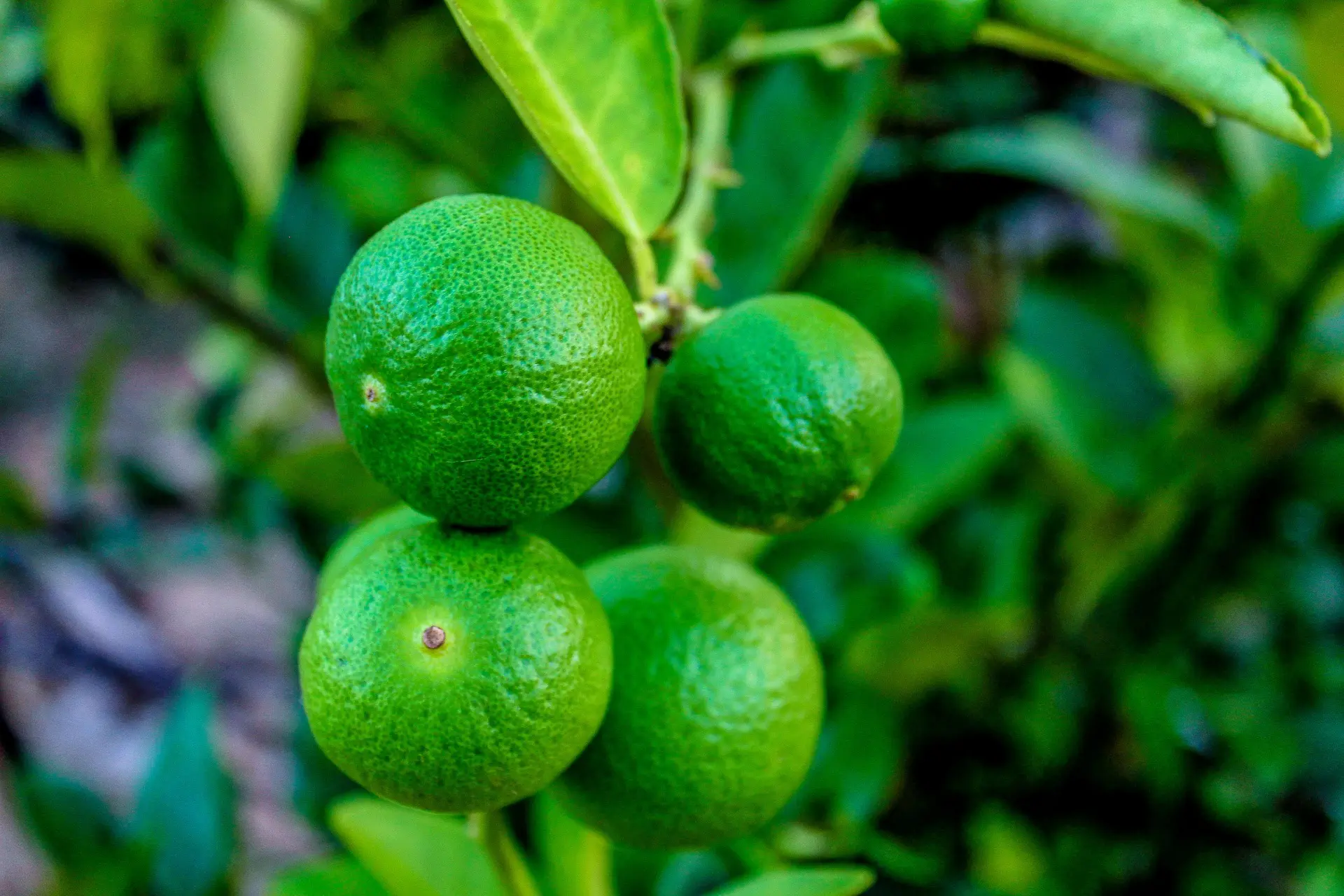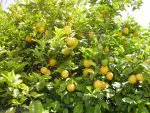This post contains affiliate links. If you buy something from one of our links we may earn a commission. Thanks

If you’re thinking about growing your own key lime plants, it’s important to understand the proper care and maintenance required to keep your tree healthy and productive.
Caring for a Key Lime tree involves full sun exposure, well-drained soil, and consistent watering. Place the tree in a location with at least 6-8 hours of direct sunlight. Water when the top inch of soil is dry and use a citrus-specific fertilizer every 4-6 weeks.
In this blog post, we’ll go over the key points for key lime tree care, including planting and location, watering and fertilizing, pruning and shaping, pest and disease management, and harvesting and storing key limes.
What Are Key Limes?
Key lime trees, also known as Citrus aurantifolia, are a popular tropical fruit tree known for their small, tart limes.
Key lime is also known as West Indian lime, bartender’s lime, Omani lime, or Mexican lime
These trees are native to Southeast Asia, but they are grown in tropical climates around the world, including Florida, California, and Texas in the United States.
Today true Florida key limes are available on a very small scale in home gardens in the Florida Keys and through farms in Dade County, Florida, but these limes make up less than ten percent of key lime sales in the United States. The majority of limes that are sold as key limes at specialty grocers and supermarkets are cultivated and imported from Mexico and Central America. More
Key Lime Care Indoors
When planting your key lime tree, it’s important to give it enough space to grow. Key lime trees can reach up to 20 feet tall and wide outdoors.
They will be smaller indoors at 6-13 feet so be sure to leave enough room for the tree to spread out. Otherwise even young trees will require constant pruning to keep their size in check.
If you are growing key lime indoors, which most of you probably are a good choice is to find a dwarf variety of key lime.
A dwarf citrus tree is usually grafted onto the flying dragon rootstock. Some varieties are considered natural semi-dwarfs.
Growing Key Limes In Containers
To plant a key lime tree indoors, you will need the following supplies:
• A small container or pot with drainage holes
• Potting soil specifically formulated for citrus trees
• A key lime tree (preferably a dwarf tree)
Here are the steps to follow:
We will be growing key limes in pots so using a dwarf key lime tree will work best.
Dwarf key lime tree care is the same as for a standard lime tree but with much less pruning needed to control its size.
Choose a container that is large enough to accommodate the root system of the dwarf lime tree, but small enough to be easily moved indoors.
A pot with a diameter of at least 12 inches is a good size for a key lime tree. Make sure your pot has drainage holes.
You can fill the container with potting soil specifically formulated for citrus trees. You can find this type of soil at a garden center or online.
Citrus requires good drainage so choose a well-draining potting mix. You can make a homemade mix with a 50/50 mix of coco coir and perlite.
Before planting your key lime tree, prepare the soil by adding compost and a slow-release fertilizer according to directions to improve the soil structure and nutrients.
They also prefer a soil pH between 6.0 and 6.5, so it may be necessary to add lime to your soil to adjust the pH if needed. Most quality potting soils won’t need this.
Remove the key lime from its current container and gently loosen the roots. Prune off any broken, damaged or dead roots.
Place the dwarf citrus tree in the center of the container and fill in around the roots with potting soil. Tamp the soil down gently to secure the tree in place.
Water your key lime tree thoroughly to remove any air pockets and place it in a location that receives plenty of sunlight, such as a south-facing window.
By following these steps, you can successfully plant a key lime tree indoors and enjoy the delicious, fragrant fruit for years to come.
Now we need to find a good place for it.
Choose The Right Location
When it comes to planting your key lime tree, it’s important to choose the right location.
 Key lime trees prefer well-draining soil and full sun exposure, so it’s a good idea to plant your tree in an area that gets plenty of direct sunlight.
Key lime trees prefer well-draining soil and full sun exposure, so it’s a good idea to plant your tree in an area that gets plenty of direct sunlight.
A sunny window can work during the summer months but the winter months have short days and low light levels.
You should consider using a full spectrum LED grow light during that time.
Find a location that has good air circulation but is free from cold temperatures and drafts.
Watering Key Lime Trees
Proper watering is crucial for the health and growth of your key lime tree. Key lime trees prefer to be kept evenly moist, but they should not be allowed to sit in standing water.
To determine if your tree needs watering, stick your finger about an inch into the soil. If it feels dry at that depth, it’s time to water.
It’s a good idea to water your tree slowly and deeply to encourage deep root growth.
Fertilizing Key Lime Plants
In addition to regular watering, key lime trees also benefit from fertilization.
There are a few different fertilizers that are suitable for key lime trees, including citrus-specific fertilizer and compost.
It’s a good idea to fertilize your tree once a month during the growing season (spring through fall) to encourage fruit production using a fertilizer that is high in nitrogen, phosphorous, and potassium.
Avoid using too much fertilizer, as this can lead to leaf burn or other problems.
Water regularly, allowing the soil to dry out slightly between waterings. Fertilize the tree every two to four weeks with a liquid citrus tree fertilizer.
Prune the tree as needed to encourage growth and remove any dead or damaged branches.
By following these steps, you can successfully plant a key lime tree indoors and enjoy the delicious, fragrant fruit for years to come.
Pruning And Shaping
 Pruning is an important part of key lime tree care, as it helps to encourage healthy growth and fruiting.
Pruning is an important part of key lime tree care, as it helps to encourage healthy growth and fruiting.
Key lime trees should be pruned annually in the late winter or early spring to remove any dead or damaged branches and to shape the tree.
When pruning, be sure to use clean, sharp pruning shears to make clean cuts.
In addition to annual pruning, it’s also a good idea to shape your key lime tree as it grows.
Key lime trees can be trained to grow with a single trunk or multiple trunks, depending on your preference.
To encourage a single trunk, remove any competing branches and prune back the main trunk to encourage lateral branching.
If you prefer a multi-trunked tree, allow the tree to grow naturally and prune off any branches that are rubbing against each other or crossing.
Key Lime Tree Care: Pest And Disease Management
Like all citrus plants, key lime trees are prone to several insect pests and diseases.
There are several insects that can affect key lime trees grown indoors, including:
Aphids: These small, soft-bodied insects feed on the sap of the tree and can cause leaves to yellow and curl. They can also transmit diseases from one plant to another.
Thrips: These small, slender insects feed on the sap of the tree and can cause leaves to become distorted or scarred. They can also transmit diseases from one plant to another. To control thrips, you can use the same methods as the aphids above.
Whiteflies: These small, white insects feed on the sap of the tree and can cause leaves to yellow and curl. They can also transmit diseases from one plant to another.
Mealybugs: These small, white insects feed on the sap of the tree and can cause leaves to yellow and curl. They can also produce a sticky substance called honeydew, which can attract ants and encourage the growth of sooty mold.
How To Control Insect Pests On Key Lime Trees
Prevention is always better than cure. Bugs will often attack plants that are unhealthy in some way so don’t neglect your everyday key lime care.
Ways to control insect pests on a key lime tree:
Physical removal: insect pests can often be removed by simply wiping them off the plant with a soft cloth or a cotton swab dipped in rubbing alcohol.
Spraying with water: insect pests can be dislodged from the plant by spraying the foliage with a strong blast of water from the hose. This can be effective for small infestations.
Insecticidal soap: insect pests can be controlled with the use of insecticidal soap, which is a specially formulated soap that is safe for use on plants.
• To use insecticidal soap, mix it according to the instructions on the label and spray it directly onto the insect pests.
• Be sure to cover the entire plant, including the undersides of the leaves, where insect pests are often found.
Neem oil: Neem oil is a natural, plant-based oil that is effective at controlling insect pests and other insects.
• To use neem oil, mix it according to the instructions on the label and spray it directly onto the insect pests.
• Be sure to cover the entire plant, including the undersides of the leaves.
Chemical pesticides: If other methods are not effective, chemical pesticides can be used to control insect pests as a last resort.
• Be sure to follow the instructions on the label carefully.
• Avoid spraying when the plant is in bloom to protect pollinators.
By following these steps, you can effectively control insect pests on your key lime tree and keep it healthy.
To prevent insects from affecting your key lime tree, it is important to keep the tree healthy by watering it regularly, fertilizing it, and pruning it as needed.
It is also a good idea to inspect the tree regularly for signs of pests and to take appropriate action if necessary.
Diseases
Citrus canker: This is a bacterial disease that causes raised, circular lesions on the fruit and leaves of the tree.
It can lead to premature fruit drop and can ultimately kill the tree. There is no cure for citrus canker, so the best way to control it is to remove and destroy infected trees and to practice good hygiene (such as washing your hands and disinfecting tools after handling infected plants).
Copper sprays are used as a preventative in citrus crops. Read more about citrus canker
Root rot: This is a fungal disease that causes the roots of the tree to rot. It can be caused by over-watering or poor drainage.
To control root rot, you can improve drainage in the soil and avoid overwatering the tree.
To prevent pests and diseases from affecting your key lime tree, it is important to keep the tree healthy by watering it regularly, fertilizing it, and pruning it as needed.
It is also a good idea to inspect the tree regularly for signs of pests or diseases and to take appropriate action if necessary.
Key Lime Tree Winter Care
Key lime trees are tropical plants that thrive in warm, humid conditions. They prefer temperatures between 60 and 85 degrees Fahrenheit, and can tolerate short periods of frost, but are not cold hardy.
Key Lime Tree Care Temperature And Hardiness
In areas with extreme winter weather, key lime trees may need to be brought indoors or provided with some form of protection, such as a burlap wrap or a plastic sheet, to prevent damage from frost or freezing temperatures.
USDA Hardiness Zone For Key Lime And Low Temperatures
In the United States, key lime trees are generally grown in USDA hardiness zones 9 through 11, which correspond to areas with moderate to warm winter temperatures.
In these zones, winter temperatures typically range from 20 to 50 degrees Fahrenheit, with occasional dips below freezing.
Key Lime Tree Care Indoors During The Winter Follow These Tips:
Keep the tree watered: Key lime trees need regular watering, especially during the winter months when the air is dry.
Water the tree deeply once a week, or more often if the soil feels dry. You can mist the tree with a spray bottle or use a pebble tray to help raise humidity.
Fertilize the tree: Key lime trees benefit from regular fertilization. Use a citrus tree fertilizer according to the instructions on the label, and be sure to fertilize the tree during the winter months to help it stay healthy.
Prune the tree: Key lime trees benefit from regular pruning to remove dead or damaged branches and to encourage new growth. Prune the tree during the winter months while it is semi-dormant.
Protect the tree from extreme temperatures: Key lime trees are sensitive to extreme temperatures, so be sure to protect the tree if temperatures drop below freezing.
By following these tips, you can help to ensure that your key lime tree stays healthy and vigorous during the winter months.
Harvesting And Storing Key Limes
When it comes to harvesting key limes, timing is everything. Key limes are ripe and ready to be picked when they are a bright green color and give slightly when pressed.
If you prefer a sweeter flavor, you can wait until the limes turn yellow before picking.
To pick key limes, simply twist the fruit gently off the tree. Be sure to use clean, sharp scissors or pruning shears to avoid damaging the branches if you decide to clip them off instead.
Once you’ve harvested your key limes, it’s important to store them properly to ensure they remain fresh.
Key limes will continue to ripen off the tree going from green to yellow.
Key limes can be stored in the refrigerator for up to a week, or they can be frozen for longer-term storage.
To freeze key limes, simply wash and dry the fruit, then slice them into thin wedges and place them in a single layer on a parchment-lined baking sheet in the freezer.
Once they are frozen, transfer the wedges to a resealable bag or container and continue to store them in the freezer.
What Do Key Limes Taste Like?
Key limes are a type of lime that is smaller and more acidic than regular limes. They have thin, yellowish-green skin and are typically more fragrant and flavorful than regular limes.
Some people describe the flavor of key limes as being sweeter and more floral than regular limes, while others say that they have a more tart and citrusy flavor.
Some people prefer the taste of key limes to regular limes, while others prefer the more mellow flavor of regular limes.
In general, key limes are used in much the same way as regular limes and can be used to add a burst of citrus flavor to a wide variety of dishes, drinks, and desserts.
Some popular dishes that feature key limes include key lime pie, key lime tarts, and key lime cocktails.
Key limes are also often used to make marinades, dressings, and sauces, and can be used to add flavor to grilled meats, seafood, and vegetables.
What Is Key Lime Pie?
Key lime pie is a popular dessert that is made with the juice and zest of key limes.
Key lime zest is the dark green peel that is grated to add a concentrated lime flavor to foods.
Key lime pie is typically made with a crust made of graham cracker crumbs, butter, and sugar, and a filling made of sweetened condensed milk, key lime juice, and egg yolks.
The filling is usually whipped to a smooth consistency and then poured into the crust and baked until set.
The pie is typically served chilled and is often garnished with whipped cream or a sprinkle of key lime zest.
Key lime pie is a classic dessert in the United States, particularly in the southern states, where key limes are grown.
It is often associated with the Florida Keys, where key limes were once widely cultivated.
Today, key lime pie is enjoyed by people all over the world and can be found at many bakeries and restaurants.
It is known for its refreshing, tangy flavor and creamy texture, and is a popular choice for summertime gatherings and celebrations.
Key Lime FAQs
Key Lime trees are the source of the famous Key Lime Pie, but there are questions that often arise when growing these citrus trees.
Whether you’re new to Key Lime tree care or looking to troubleshoot, here are some FAQs and their answers to guide you.
Q: How often should I water my Key Lime tree?
A: Water the tree when the top inch of soil feels dry, avoiding overwatering to prevent root rot.
Q: What type of fertilizer works best for Key Lime trees?
A: Use a citrus-specific fertilizer every 4-6 weeks for best results.
Q: Do Key Lime trees need to be pruned?
A: Yes, prune in late winter or early spring to remove dead or diseased branches and to shape the tree.
Q: Can Key Lime trees be grown indoors?
A: Yes, they can be grown indoors but require plenty of sunlight and proper humidity. Consider using a grow light if necessary.
Final Thoughts
Key lime trees are a delicious and attractive addition to any home and adapt well to indoor conditions.
With their evergreen leaves and fragrant flowers, they add a touch of tropical beauty to any room.
With proper key lime tree care, including proper planting and location, regular watering and fertilizing, annual pruning and shaping, and pest and disease management, you can enjoy a healthy and productive key lime tree for years to come.
Don’t forget to harvest and store your key limes properly to ensure you can enjoy their fresh flavor all year round with delicious key lime pies.
Here is more info about growing indoor citrus trees you might like.







